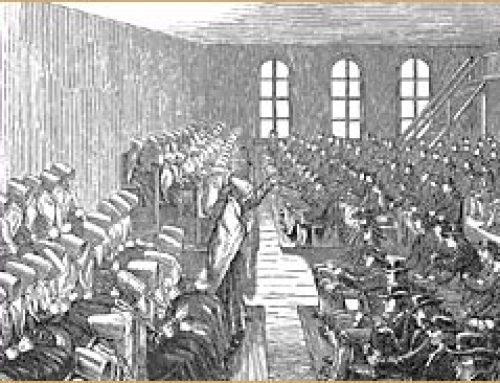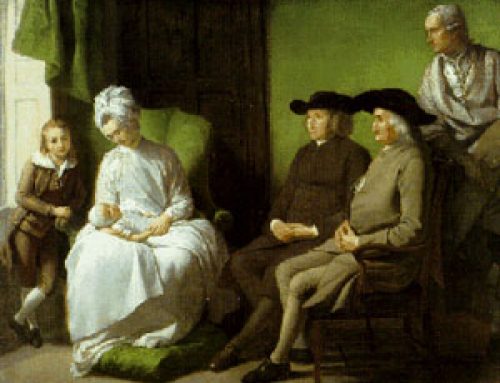
Thomas Hobbes – European philosophy
Thomas Aquinas
In the 900s and 1100s AD, the Islamic philosopher al-Razi and the Jewish philosopher Maimonides were working on how their religious beliefs could match up with Aristotle. By the 1200s, Europeans like Roger Bacon had heard about this, and Bacon’s student Thomas Aquinas wrote about the same problem, but for Christianity.
Greek philosophy
Roman philosophy
Islamic philosophy
All our modern Europe articles
Aquinas agreed with Maimonides that God didn’t really look like a man, but was more like a spirit or idea. But Aquinas disagreed with Ibn Rushd’s idea that when you died, your soul mixed back into one big soul. Some Christians agreed with Ibn Rushd, but Aquinas insisted that each soul remained itself and lived on after death, in heaven.
More about Thomas Aquinas

René Descartes
Thomas Aquinas disagreed with both Ibn Rushd and Maimonides about why people should be good. Maimonides and Ibn Rushd said that following the rules of their religions would make you happy on earth. Aquinas thought the point was to get go to Heaven.
Protestantism in Europe
Europeans sailing around the world in the 1400s and 1500s AD brought back a lot of new ideas from the Americas, Africa, and Asia. From Ethiopia, the work of Zera Yakob suggested that logic and reason could answer all questions, and that all religions had some things right and some things wrong. Native American ideas about leadership suggested that it was wrong to force people to follow you. Asian philosophies like Taoism and Confucianism also came to Europe. People wanted to know what to believe. How could you know? In the 1500s AD, the Protestant ministers Calvin and Luther suggested that people should read the Bible for themselves and decide what God wanted on their own, instead of letting priests tell them.
Calvin and Luther

Margaret Cavendish
Thomas Hobbes
Thomas Hobbes, in the early 1600s, justified enslaving Africans and Americans by claiming that everyone lived better inside an organized system of government with property rights and taxes and courts. Without that, it would be like the Purge, everyone just running around killing each other.
More about Hobbes
Native American government
History of the Kongo
African-American slavery
(This is wrong in several ways: 1) Most people get along fine without a government and don’t kill anybody 2) Africans and Native Americans were living inside complicated systems already 3) Enslaved Africans were much worse off living inside the European system.) Hobbes thought kings should rule countries, and men should rule families (including telling women what to do).
Rene Descartes and Margaret Cavendish
Then in 1630, Rene Descartes wrote that people should only believe things you could prove were true. You could start from basic ideas that everyone agreed were true, and build on that using reason and logic. Descartes also thought people’s souls were different from their bodies, while Hobbes argued that they were the same thing. Margaret Cavendish, who was just a little later, wrote that she didn’t even believe people had souls, since you couldn’t see them or touch them.
More about Descartes
Margaret Cavendish

John Locke
John Locke
So after Descartes and Cavendish, European philosophers tried to figure out what we really knew, and how you could build on that. John Locke, for example, argued in the late 1600s that we only know things through our senses. He answered Hobbes by saying that although we needed a government, we didn’t need kings: governments should rule by the consent of the free men in them. Locke may have gotten the idea of consent from Native American communities. Locke thought scientists should start from observations and then draw conclusions.
More about John Locke
Mary Astell
Locke didn’t speak out against slavery or the oppression of women, but right away Mary Astell wrote that governments should get the consent of women, too. Strength, she said, did not determine who should have power. Astell also argued that education and love were the paths to get closer to God. Locke’s friend Damaris Masham, still in the late 1600s, answered Astell that loving people on earth could show you how to love God better. But Masham, like Descartes, was more about using science and reason to bring you closer to God. Masham thought women should get good educations so they could raise children with good morals.
More about Mary Astell
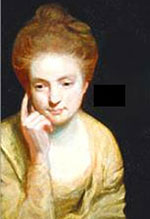
Mary Astell
David Hume
David Hume, in the early 1700s, agreed with Hobbes that people needed a government to keep them from doing bad or foolish things. He thought a little inequality was good, because it made people work harder instead of being lazy. Hume followed Descartes and Masham’s interest in facts and logical reasoning, and Cavendish’s argument about souls, but he went further and said that he didn’t believe in God at all, since we couldn’t prove that God existed.
More about David Hume

David Hume, the European philosopher
Anton Wilhelm Amo
Amo was the first European philosopher who was black. He was originally from Ghana, and he came to Europe by force. Then he got a PhD in philosophy from the University of Wittenberg in 1734, and got a job teaching at the University of Halle. Amo argued, like Descartes, that the mind and the body were two different things. But he argued that it is the body, not the mind, that gathers information by seeing, hearing, smelling, or feeling. Amo also argued that enslaving Africans, who had been bound by treaties to Rome, was illegal under international law.
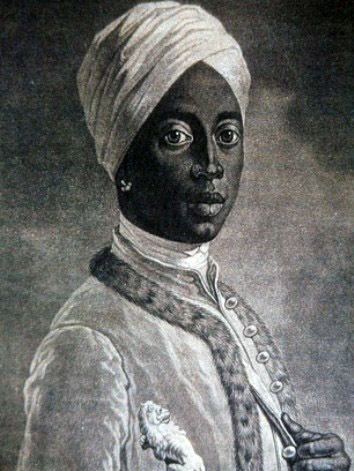
Anton Wilhelm Amo – European philosophy
Voltaire and Emilie du Chatelet
Voltaire agreed that organized religion flew in the face of logic and reason, but he did still believe in God. His logic and reason (and his partner, the scientist Emilie du Chatelet) helped him to see that women and Native people should also have natural rights. So Voltaire opposed slavery and colonialism. Du Chatelet argued against Locke that scientists should try to figure out natural laws from mathematics and principles, and then do experiments to see if their ideas were correct.
Who was Voltaire?
More about Emilie du Chatelet

Voltaire – a French philosopher
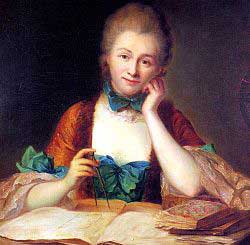
Emilie du Chatelet, a French philosopher in the 1600s
Jean-Jacques Rousseau
About the same time, Jean-Jacques Rousseau agreed with Locke, that people needed governments and that they should operate by a “social contract”, an agreement among men. Like Locke, Rousseau didn’t think women should participate. Rousseau disagreed with Hobbes and Hume that people were naturally bad or lazy. He said they were naturally good, but foolish sometimes.
More about Rousseau

Jean-Jacques Rousseau, a European philosopher
Thomas Paine and Mary Wollstonecraft
Thomas Paine, in the American colonies, pushed Locke’s ideas forward to say that consent wasn’t enough. People shouldn’t give up their natural rights to their government. Instead, their government should help them to keep those rights, and just represent the people’s wishes. He said slavery was wrong too. Paine’s friend Mary Wollstonecraft went further than that: she said that everyone should be equal under the law, and also in terms of how rich they were – people shouldn’t inherit wealth from their parents. And, she said, she meant both men and women. Each family should have a small farm to support them. Paine supported Wollstonecraft’s view of equality for women.
Thomas Paine
Mary Wollstonecraft

Thomas Paine (by Matthew Pratt, about 1790)

Mary Wollstonecraft – European philosophy
Immanuel Kant
In the end of the 1700s, Immanuel Kant pointed out that even if we do rely on our senses to know facts, the way Descartes and Locke suggested, knowing facts won’t get us anywhere unless we also use logic and reason to interpret the facts and draw conclusions. Just knowing a lot of facts isn’t useful. Like Voltaire, Kant rejected organized religion but still said he believed in God.
Immanuel Kant
The American Revolution
The French Revolution

Emmanuel Kant – European philosophy
Georg Hegel and dialectic
After the American Revolution and the French Revolution were over, people were tired of human rights and governments. Georg Hegel, in the early 1800s, wrote about dialectic – argument between two opposites. He said that dialectic helped us to understand both sides better, and brought us closer to understanding the whole universe, and God, as one unified thing. He thought compromise was always the right way forward. Men and women were in dialectic, for example, but together, they became the family.
More about Hegel

Georg Hegel, a European philosopher
Karl Marx and Communism
In the late 1800s, though, Karl Marx went back to thinking about governments. Marx, living in a time when a few people were very, very rich, combined Rousseau’s ideas about government with very old ideas about the redistribution of land and the abolition of debt. The spread of factory work made Wollstonecraft’s ideas about small farms seem out of date. So Marx suggested that people should own the factories they worked in, and share the profits among themselves. His ideas came to be called Communism, and they encouraged two new revolutions in Russia and in China.
More about Marx
The Russian Revolution
Republic of China

Karl Marx, a European philosopher and economist
Jean-Paul Sartre
But World War I and World War II made those rich people much less rich than before. So after the wars, in the 1900s, Jean-Paul Sartre wasn’t as interested in economics. He called himself an anarchist. Like Rousseau, he thought people were basically good. But even more: Sartre thought people would be fine without either religion or government to make them good.
World War I
World War II
Jean-Paul Sartre

Jean-Paul Sartre – a French philosopher

Simone de Beauvoir – European philosophy
Simone de Beauvoir
Sartre’s friend Simone de Beauvoir explored related questions. She asked whether we can see ourselves the same way throughout our lives. Aren’t we different, with different needs, when we are children, or when we are old? And women, also, she said, should be free to live their lives as women, with different needs from men, not just by being treated exactly like men. As a bisexual in an open relationship with Sartre, Simone de Beauvoir lived her philosophy.
More about Simone de Beauvoir
Women in modern Europe
Did you find out what you wanted to know about European philosophy? Let us know in the comments!

